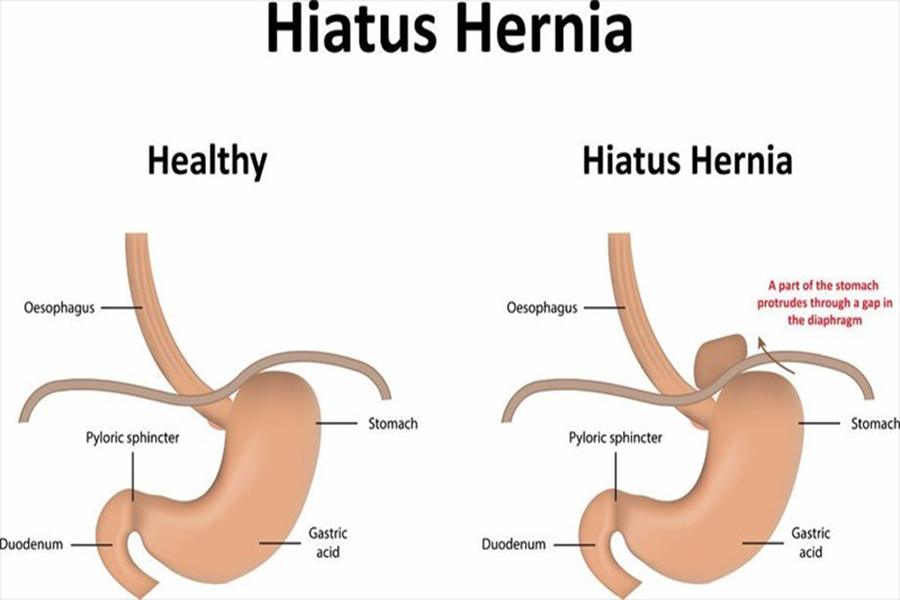
Sadbhavna is considered as one of the Best hernia hospital in Ahmedabad,The esophagus passes through an opening in the diaphragm (i.e. esophageal hiatus) as it courses through the chest to the abdomen eventually ending at the stomach. This opening is usually adequate for passage of the esophagus and nothing else. However, patients that have a hiatal hernia have an enlarged opening. There are four different types of hiatus hernias described. A sliding hernia is the most common of the four representing more than eighty-percent of all hiatus hernias. The lower esophageal sphincter- the high-pressure zone near the junction of the stomach and esophagus- fails and allows stomach contents to reflux into the esophagus.
Upper endoscopy:
Laparoscopic Cruroplasty and Nissen fundoplication is the procedure of choice for repair of a hiatal hernia. Patients that have a para-esophageal hernia which allows the fundus to be displaced into the chest above the GE junction or patients with other abdominal organs (e.g. spleen, colon, liver) displaced into the chest should be repaired urgently. A repair will help prevent complications such as bleeding, intestinal disruption, strangulation and the like. Elective repair is recommended only for patients that are asymptomatic and have a sliding hernia. This group of asymptomatic patients may also be followed clinically seeking surgery only when symptoms arise
In the past, open surgery was the only option for repair. This approach is associated with prolonged recovery time and a large painful incision. With the new minimally invasive approach, surgery is now a viable initial therapy even for patients who are asymptomatic
The laparoscopic Cruroplasty and Nissen fundoplication are performed through five quarter-inch incisions through which, a camera and instruments are placed. A hernia is reduced from the chest into the abdomen. This may require separation of abdominal organs from the lung and middle chest structures. The hiatus is then re-approximated to the appropriate size. Some hernias are so large and tissues are so poor that prosthetic material must be used to prevent recurrence. After adequate repair of the hiatus, a new lower esophageal valve is constructed by wrapping a two-centimeter portion of the stomach around the lowermost portion of the esophagus. This collar is then anchored to the tough fibers of the diaphragm. The procedure typically lasts for two to four hours depending on the size and contents of a hernia. Patients are started on clear liquids the next morning and are discharged in the afternoon. The open surgical technique involves an 8-10 inch upper abdominal incision with a hospital stay of 5-7 days.
Patients recover sooner after laparoscopic Cruroplasty and Nissen fundoplication. Return to activities can occur within 2-7 days compared to 4-6 weeks with an open approach. Wound infections occur less frequently with the laparoscopic technique. Also, less pain has been reported with laparoscopy. Most importantly, greater than ninety-percent of patients are symptom-free ten years after the procedure.
Benefits— An operation is the only way to repair a hernia. You can return to your normal activities and, in most cases, will not have further discomfort.
Risks of not having an operation— The size of your hernia and the pain it causes an increase. If your intestine becomes trapped in the hernia pouch, you will have sudden pain and vomiting and require an immediate operation.
possible risks include return of the hernia— infection; injury to the bladder, blood vessels, intestines, or nerves; and continued pain at the hernia site
Before your operation— Evaluation may include blood work, urinalysis, ultrasound, or a CT scan. Your surgeon and anesthesia provider will review your health history, home medications, and pain control options.
The day of your operation— You will not eat or drink for six hours before the operation. Most often, you will take your normal medication with a sip of water. You will need someone to drive you home
Your recovery— For a simple repair, you may go home the same day. You will need to stay longer for complex repairs
Call your surgeon if you have severe pain, stomach cramping, chills with a high fever (higher than 101°F), odor or increased drainage from your incision, or no bowel movement for 3 days.